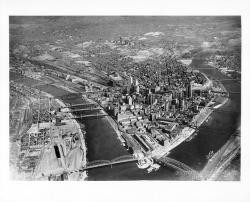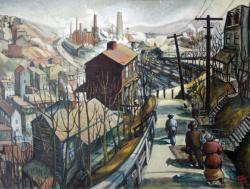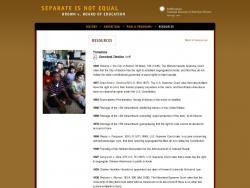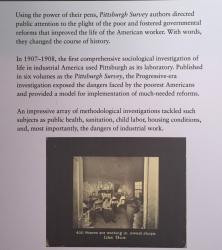Kate Harris
Social Studies teacher
Pittsburgh CAPA
Middle School (13 to 15 years old), High School (16 to 18 years old)
Teacher/Educator
Language Arts And English, Civics, Literature, Cultures, Economics, Social Studies, Geography, Writing, US History, Arts, Other
I'm a history-lover, art fan, and bookworm. I taught high school history (U.S. History and World Religions) for ten years in North Carolina, teach currently in Pittsburgh, PA, and am working to help teachers make the most of this new resource!
Kate Harris's collections
Sacco and Vanzetti
<p>Students may use this collection to explore the reasons why Sacco and Vanzetti became a celebrated cause among liberal activists in the 1920s, and how their trial exemplified cultural divisions that emerged during the decade. Examining artists' perspectives on the trial through visual arts and music will help provide insight into the era. </p>
<p>Tags: 1920s, Twenties, immigration, nativism, anarchy, socialism, Red Scare, crime, justice, inquiry, continuity and change</p><p><em>#historicalthinking</em></p><p><br /></p>
 Kate Harris
Kate Harris
11
Rebels and Beats
<p>This topical collection is based on a past exhibit in the National Portrait Gallery entitled <a href="http://www.npg.si.edu/exh/rebels/index2.htm" target="_blank">Rebels and Beats: Painters and Poets of the 1950s</a>. This collection might be used by teachers or students who want to explore the counterculture of the 1950s, a time period typically associated with conformity. The collection includes paintings, photographs, and videos related to the writers and artists involved in the Beat Generation, San Francisco Renaissance, Black Mountain College, and New York School scenes. </p><p>In what ways did these artists challenge the social norms of the time? Why is art often a means of challenging the status quo?</p><p>tags: Ginsberg, Kerouac, Ferlinghetti, de Kooning, Baraka, poem, counterculture, Beat Movement</p>
 Kate Harris
Kate Harris
44
Frederick Douglass and "What to the Slave Is the Fourth of July?"
<p>In this collection, students will review the life of Frederick Douglass and learn about one of his most famous speeches, "The Meaning of Fourth of July for the Negro" (it is also commonly referred to as "What to the Slave is the Fourth of July). They will explore the strategies he uses to persuade and compare staged readings of the speech. Next, they will consider the central question posed by Douglass--how does the history of racial injustice in the United States affect our understanding of national symbols and what they mean? In addition, how do the diverse opinions of the many citizens of the United States present both challenges and opportunities for our nation? </p><p>Teachers may draw relevant connections to today and recent protests during the national anthem by professional, collegiate, and high school sports teams. </p>
 Kate Harris
Kate Harris
13
Pittsburgh's Urban Renewal
<p>This collection was created to support a workshop on integrating primary sources and student writing for teachers at Peters Township High School. These resources can be used to design a document-based question to answer the following inquiry:</p><p>Were Pittsburgh's urban renewal programs in the 1950s and 60s ultimately helpful or harmful?</p><p>Teachers may want to excerpt the documents included in this collection before giving them to students to use. You may also want to introduce students to the concept of "purposeful annotation" as they read through the documents (resources included).</p><p>Finally, an articles on urban renewal today and a lesson plan from Global Oneness Project on gentrification and urban renewal in Seattle provide additional resources for teachers.</p><p>Tags: C3, Inquiry, urban renewal, demolition, construction, slums, Teenie Harris, Charles Olmstead, Pittsburgh</p>
 Kate Harris
Kate Harris
17
Take Action on Air Pollution
<p>This collection of resources invites students to examine how societies have been convinced to take action regarding air pollution over time, and to craft their own persuasive message regarding pollution. Students will identify several different means of compelling individuals and groups to change their behavior in order to benefit the environment. They will then evaluate the effectiveness of those strategies. Finally, they will create their own message convincing others to take steps towards improving the environment. </p><p>Tags: smoke control, smog, pollution, environmentalism, earth day, advertising, persuasive writing, ad campaign</p>
 Kate Harris
Kate Harris
9
Claim-Support-Question: A Sharecropper's Shack
Using the Project Zero Visible Thinking routine "Claim Support Question," a routine for clarifying truth claims, students will examine a photograph taken by Carl Mydans for the Farm Security Administration. This exercise could be used as a warm up for a lesson about the Great Depression's impact on farmers, sharecropping, or the New Deal.
Tags: Roosevelt, New Deal, Farm Security Administration, Great Depression, tenant farmer, sharecropper, migrant farmer, Okie, Missouri, Oklahoma, Dust Bowl, Resettlement Administration.
 Kate Harris
Kate Harris
4
School Integration
<p>The topic of K-12 school integration is a complex one that goes far beyond an understanding of that landmark case, Brown v. Board of Education of Topeka, Kansas. How have efforts at integration been sustained in the 60+ years since that case was first decided? How have concerns about socioeconomic differences been addressed (or not addressed) through school districting? How do district and national policies impact individual students for better or worse? This is a topical collection that addresses the history of school integration but also includes references to and resources reflecting the issue today.</p><p>Tags: segregation, Little Rock Nine, desegregation, charter schools, Arkansas, busing, Boston, racism, prejudice, civil rights</p>
 Kate Harris
Kate Harris
14
The Military Draft
<p>This collection can be used for a teaching activity on the military draft in the United States and how it has changed over time from the Civil War to the Vietnam War. Students will consider attitudes towards the draft, its effects, and means of avoiding the draft in different eras. What trends or patterns emerge? What changes? Why is the draft no longer in use?</p><p>Tags: conscription, draft, selective service, Civil War, World War I, World War II, WWI, WWII, WW2, Vietnam War, change over time, continuity and change, exemption</p>
 Kate Harris
Kate Harris
23
"Women's Work"
<p>This collection explores the conception of "women's work" and challenges users to think about whether such a phrase has meaning. </p><p>Teachers and students can use the collection in a number of ways: grouping or sorting the resources chronologically to explore change over time; writing definitions of "women's work" for different time periods; completing image or text analysis on individual resources; or researching women's contributions in a particular field. </p><p>This is a work-in-progress based on the digitized materials within the Smithsonian Learning Lab's collection--it is not meant to be wholly definitive or authoritative. In fact, this could be a point of discussion: what, or who, do you think is missing from this collection?<br /></p>
 Kate Harris
Kate Harris
35
Dulce et Decorum Est--Poetry from World War I
<p>Why are artists' representations of war important? This student activity uses a poem by Wilfred Owen, "Dulce et Decorum Est," and several images to encourage reflection on soldiers' experiences and views of war. Students will explore the descriptive language and artistic choices made to determine what emotions are evoked by the art and what attitudes towards war are represented. Finally, students will be asked to consider and write about their own beliefs regarding war.</p>
 Kate Harris
Kate Harris
9
Visions of the Future
This student activity includes a range of visions of the future, to serve as inspiration and present a challenge for students: what do you want your city to be like in the future?
Students will watch a video where students complete a similar project, and then view a variety of artifacts presenting different views of the future, with questions for analysis. Finally, students will be tasked with developing their own vision for their city or town in the future.
 Kate Harris
Kate Harris
15
Signs of the Times
This collection includes sixteen signs and posted notices from across the Smithsonian's collections. Use your history detective skills to figure out what you can about the sign--but don't look at the information tab! Can you determine the context for each sign, matching it to a place and decade in United States history? Consider who it might have been aimed at and for what purpose it was used. Be as specific as possible. The first resource models a historian's thinking and questioning process for students to mimic with other signs in the collection. Answers are listed on the last resource.
Tags: historical thinking, questions, review activity
 Kate Harris
Kate Harris
17










